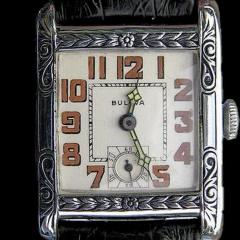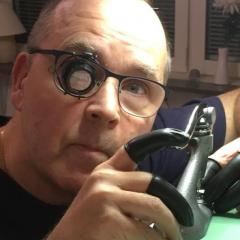Cleaning and removal of jewels
-
Recently Browsing
- No registered users viewing this page.
-
Topics
-
Posts
-
That will mean dismantling the gear train, which with 5 pivots to align was a pain. Probably going to have to though. I'm convinced it's something to do with the great wheel.
-
As far as I know, the only time an epilame treatment has potential drawbacks is when something is rubbing on the treated part w/o lubrication in between creating abrasive dust. That is, I don't believe in the method of "running the watch to make a groove through it first in the pallet stones where the lubrication is then placed". So, I think the rule would be; do not epilame treat parts where rubbing is going on without lubrication. Other than that I don't think we have anything to worry about. That said, I'm not an expert, and I'm always happy to learn more. Has any other repairer than Alex suggested or explained the "making-a-groove" method? My impression is that it's just something he constructed in his mind. I have not perceived it as a generally practiced method. Again, I could be wrong!
-
By Neverenoughwatches · Posted
Post some pictures , some good close ones of the parts you've described. -
By Neverenoughwatches · Posted
Ive never used epilame H only information i have read and mentally stored about it mostly from Nicklesilver here and elsewhere ( the fork horns thing ), maybe the residue powder that is removed has some grinding effect ? So probably a good idea to limit its application areas to only the absolute necessary. Yes as far as i know epilame rubs off relatively easy, the technique of running the watch to make a groove through it first in the pallet stones where the lubrication is then placed. This i understand creates the barrier for the lube to sit up to. If i can find a good balance of pros and cons of its use then thats one process i can avoid by using a thixotropic lube on the stones. The epilame i would say allows for a more fluid lubrication to be used that would increase amplitude on low beat movements. The stearic acid powder is extremely cheap, the problem is the fuming process to coat parts, is not selective , the whole part has to treated in this method. If epilame residue can cause wear then thats not good, if I remember the conclusion was not proved entirely just a general assumption between watchmakers. The thread is out there somewhere, the same discussion is also old on a facebook group. Ive never used epilame H only information i have read and mentally stored about it mostly from Nicklesilver here and elsewhere ( the fork horns thing ), maybe the residue powder that is removed has some grinding effect ? So probably a good idea to limit its application areas to only the absolute necessary. Yes as far as i know epilame rubs off relatively easy, the technique of running the watch to make a groove through it first in the pallet stones where the lubrication is then placed. This i understand creates the barrier for the lube to sit up to. If i can find a good balance of pros and cons of its use then thats one process i can avoid by using a thixotropic lube on the stones. The epilame i would say allows for a more fluid lubrication to be used that would increase amplitude on low beat movements. The stearic acid powder is extremely cheap, the problem is the fuming process to coat parts, is not selective , the whole part has to treated in this method. If epilame residue can cause wear then thats not good, if I remember the conclusion was not proved entirely just a general assumption between watchmakers. The thread is out there somewhere, the same discussion is also old on a facebook group. If its a potential problem for amateurs to use then i would prefer not to take the risk . -
Following on from my question about identifying screws in the AS2063 movement that basically fell out of the case in bits, I’m pleased to report that I’ve got it all back together, and the movement is running pretty well. But… There’s something wrong with the keyless works and hand setting. It’s fine in winding and quickset date position - these work - but in hand setting position winding the crown turns the whole gear train. I don’t really understand how it’s meant to work. It doesn’t have a traditional friction fit cannon pinion. The second wheel is unusual with a pair of smaller pinions on it, which seem to interact with the barrel and the motion works. Could this be the problem? I must admit I just cleaned it and popped it in place when reassembling the gear train. I’ve lubricated the pivots but didn’t do anything to the extra bits on the second wheel. Does this make sense and is anyone able to figure out what I’m doing wrong? Thanks in advance, as always. ETA - the parts list calls it the Great Wheel, not second wheel.
-







Recommended Posts
Join the conversation
You can post now and register later. If you have an account, sign in now to post with your account.
Note: Your post will require moderator approval before it will be visible.